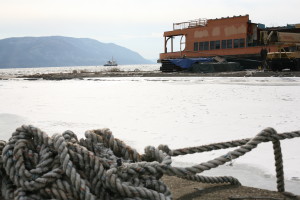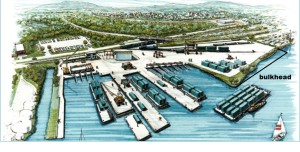Once a thriving port, Newburgh reclaims its past for the future
From an industrial site crossed by a busy freight rail line on the Hudson waterfront at Newburgh, David Plotkin over 45 years has built a steel design and fabrication business whose forte, he says, “has always been large, one-of-a-kind projects.”
There was the 16,000-ton steel deck replacement project for the Throgs Neck Bridge and the Williamsburg Ferry Dock fabrication job in New York City, where Plotkin”™s Steelways Inc. has a near monopoly on steel swimming pools for high-rise rooftops.
There were the four 165-foot-deep caissons that Steelways transported upriver by channel-bottom-scraping barge in 82-foot-high sections for the Newburgh-Beacon Bridge.
The Steelways shop on Newburgh”™s South Water Street, where 35 workers are employed this winter, has supplied floating caisson gates for U.S. naval shipyards from the East Coast to Pearl Harbor.
At the height of the Cold War, Plotkin recalled, Steelways in Newburgh was said to have earned a “red dot” on the Soviet Union”™s map of nuclear missile targets as it built a 500-foot-long by 100-foot-wide dry dock pontoon from which nuclear missile-armed U.S Trident submarines were launched at the General Dynamics Electric Boat shipyard in Groton, Conn.
The Trident project was the last job of the magnitude of one that his 54-year-old company hopes to land and deliver closer to home, Plotkin told a shivering group of business leaders and elected officials at a Jan. 31 press conference in the Steelways yard, where passing trains on the CSX line occasionally interrupted speakers.
Partnering with another company, Steelways that day submitted a bid to Tappan Zee Constructors L.L.C. to supply the precast concrete deck system for the new Tappan Zee bridge. The winning contractor will build 7,000 individual deck pieces over three years, Plotkin said. For Hudson Valley union workers in the building and construction trades, it would create 150 to 200 jobs in Newburgh.
Though he could not disclose the amount of his company”™s bid, the Steelways president said his barge shipping costs should be “a lot less” that other companies competing for the Tappan Zee contract. Plotkin said his is likely the closest facility to the bridge construction site about 30 miles downriver.
The precast decking would be manufactured on a parcel in the town of New Windsor that is part of the approximately 75-acre Steelways property and transported across Water Street to the river, Plotkin said. The large-scale project would require access to an adjacent 3-acre parcel on the Hudson that is owned by the city of Newburgh.
That need has led to a conceptual plan, approved in late January by the Newburgh City Council, to rebuild the port of Newburgh this year through a public-private partnership. U.S. Rep. Sean Patrick Maloney, the first-term Democrat whose 18th congressional district includes Newburgh, at the press conference said the $16.5 million project ”“ which includes a $3 million payroll – is expected to be aided by state and federal grants and financial incentives from the Newburgh Industrial Development Agency. In addition to Steelways as a private partner, Tappan Zee Constructors could participate in the project, an aide to Maloney said.
Plotkin said the deepwater port will require construction of a bulkhead along the city parcel just north of the Steelways yard and improvements to the company”™s piers. Only “minimal” dredging will be needed, he said.

Steelways this winter is completing almost two years of work on a 50-foot by 200-foot crane barge under a $10 million contract with the U.S Army Corps of Engineers, which will use the vessel for clean-up work on the Mississippi River. Delivery is due in May, after which Steelways will begin construction of the port, Plotkin said. The project could be completed by late summer.
Plotkin”™s steel design and fabrication company has roots in Westchester County. He founded the business in Mahopac in 1960 and later moved it to Granite Springs. In 1969, he relocated Steelways to the riverfront site in Newburgh. “Our intention was to build barges,” he said.
The property was previously owned by New York Trap Rock, which built and maintained its wooden barges that hauled quarried rock from the region. Though most buildings on the site had been leveled, Plotkin inherited two concrete piers that he said were built by the Pennsylvania Coal Co. in the late 19th century. The Newburgh port had been a vital terminus connecting river and rail transportation and from those still-standing piers coal was shipped by barge to New York City and New England.
Public officials hope to revive for a 21st century economy a port that a century ago supported ship-building yards and shipping-related companies, machine shops, brickyards, cloth manufacturers, plaster works and clothing design businesses.
“Newburgh has got tremendous geographic location” with its Hudson River port, its proximity to interstate highways and the only commercial rail line between New York City and Albany, Plotkin said. “This is the busiest line in the whole Northeast,” he said of the CSX railroad, over which 54 trains on average pass daily.
“This is a place where business moves people and goods, and we do need to take advantage of it,” Newburgh Mayor Judy Kennedy said at the press conference. Pointing to the bipartisan coalition of city, Orange County, state and federal officials supporting the port project, she said, “Let Washington watch what is happening here and take it as an example of what we should do all across the nation.”
State Senator William J. Larkin Jr., a Republican, praised the Democratic congressman Maloney for making the port project “a can-do project for all of us.”
“We have a golden opportunity now to say, ”˜This is Newburgh. This is a city that is rising, not falling,”™” Larkin said.
Maloney said, “We think this city can be an economic engine for the whole region”¦This project and Newburgh”™s development will spur additional economic development throughout the region.”
Meanwhile, Plotkin awaits a bid award announcement from Tappan Zee Constructors. Three years of bridge deck work at Steelways “would be a good start for the Port of Newburgh,” he said.
